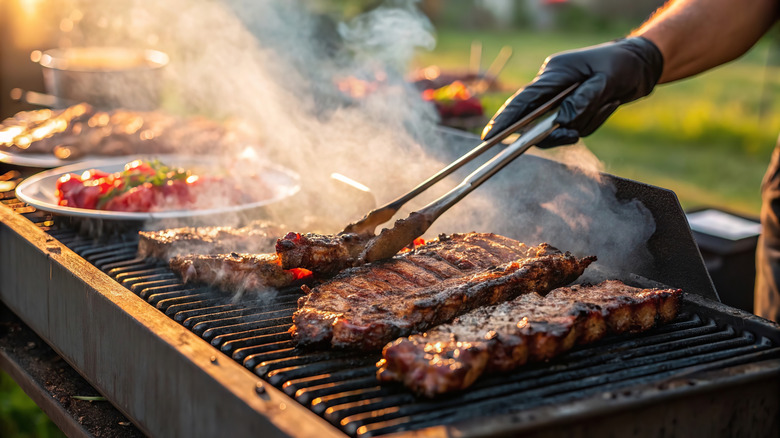Where Did The Term 'Barbecue' Come From?
Food tells a story. Recipes pass down through generations, ingredients move across continents, and cultures blend together. Oftentimes, layers of history are reflected in the name of a dish. Take the term "barbecue"; we use it to describe a type of food, a cooking process, a form of grill, and a social event. Interwoven into American culture — especially in the South — the word appears readily, but its roots are often forgotten.
Untangle the origin of the term "barbecue" and a rich history is revealed. It appears in English since at least the 17th century, likely transformed from barbacoa. In turn, experts believe this Spanish word evolved from contact with Amerindian languages in the Caribbean, specifically the Taino, a subgroup of the Arawak. Some cite the term originated from the wooden structure called a barbakoa, while others the cooking process named barabicu.
The Taino people inhabited the island of Hispaniola, where Europeans (perhaps including Christopher Columbus) first encountered barbecue. Subsequently, the technique of slow-cooking meats moved alongside explorers of the New World. In Mexico, the barbacoa name continued or differentiated into birria with the use of broth. Meanwhile, the preparation spread throughout the South, assimilating further European and African influences and delineating into regional substyles. Centuries down the line, distinct foodstuffs, such as Texas brisket, North Carolina pulled pork, and jerk chicken, all coexist under the barbecue name — a showcase of the New World's intertwined culinary history.
The word 'barbecue' emerged in the Caribbean
Dive into barbecue's earliest creation, and the term's encompassing nature becomes evident. On the Caribbean islands and Florida, the cooking technique preserved the meat. Early explorers encountered how Indigenous people smoked varying available foods: Fish, poultry, reptiles, vegetables, and more. They employed wood with more moisture intact, thereby preventing rapid burning and warding off insects. The meat would be placed above ground on a wood-built structure referred to as a barbakoa, and the technique — which often came affiliated with spiritual connections — called barabicu. With abundant sun exposure and slow smoke, the resultant foodstuff dehydrated, thereby remaining edible for extended periods.
Early Spanish explorers noted the pleasant aroma of the smoke — still a beloved barbecue attribute — so they applied the cooking technique to animals brought over from Europe, most namely pork. Throughout much of barbecue's history in America, pigs turned into the prevalent barbecue protein. And, since the animal could graze freely, it overtook areas. For such a reason, islands, such as the aforementioned Hispaniola, remained barbecue hotspots into the 17th century. French colonizers would hunt for game and set up expansive slow-cooking operations to sell meat to passing sailors. Utilizing techniques from the Tupi people of Brazil, the method was named boucanning, which some suggest influenced the barbecue name. The process evolved across the Caribbean, melding African, varying Indigenous, and European culinary influences. In parallel to development in the South, distinctly Caribbean seasonings and dishes — most famously jerk chicken — cemented barbecue's expansive nature.

